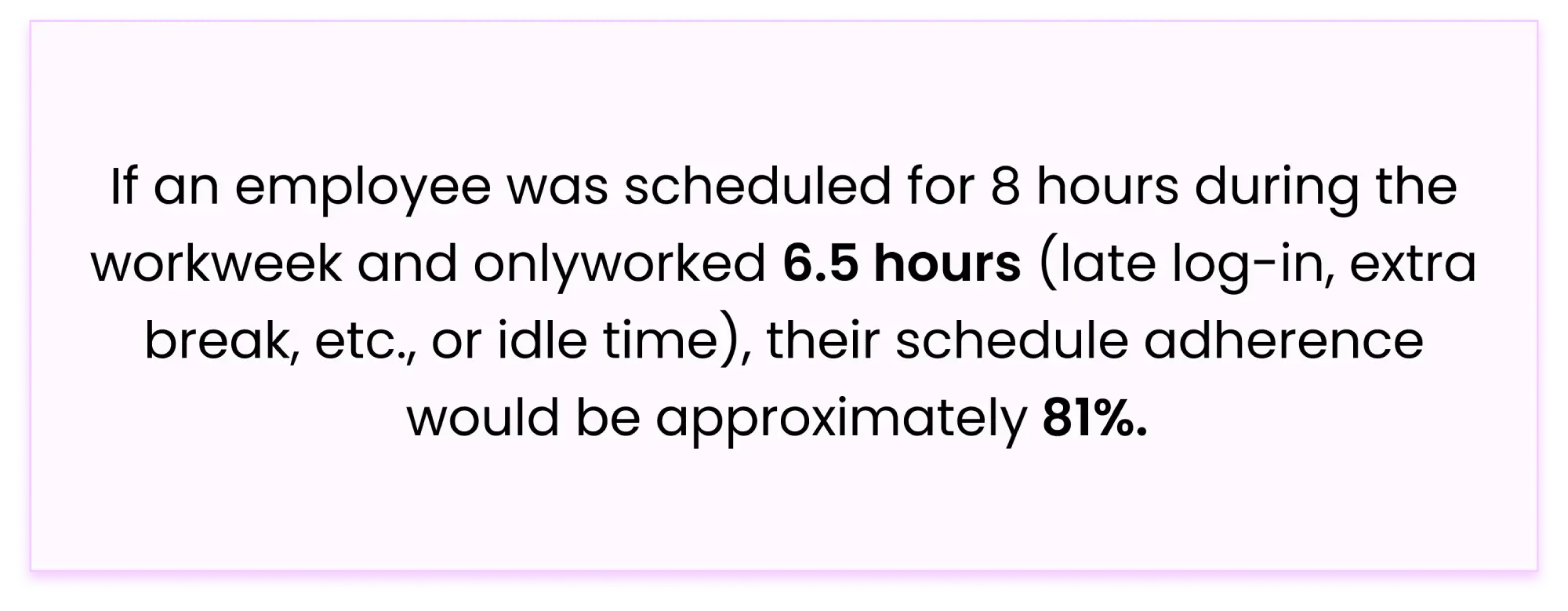Schedule adherence is essential when the goal is time and productivity. Schedule adherence is when employees stick to their assigned work schedule . There are industries like call centres, support teams, and time-sensitive departments that treat schedule adherence very seriously. For these industries, even the slightest decline, even a 0.5% drop-in schedule adherence can make a large impact on service levels, team performance , and each customer's experience.
In this blog post, you will learn about schedule adherence; what it is, how it works, some of the elements associated with schedule adherence, some common examples of schedule adherence, and a straightforward, thorough recommended solution to quantify schedule adherence. You will also learn about a few of the challenges teams encounter when trying to improve schedule adherence, as well as some suggestions to tackle these challenges.
What is Schedule Adherence?
Schedule adherence measures whether employees are actually keeping to their schedule in terms of shifts they are slated to work, breaks, and login/logout times . Adherence in itself does not mean presence; adherence is the employee's presence at the time they are supposed to be present; for instance, if an agent is slated to start work at 9:00 am, but they logged in at 9:15 am, they will have lower adherence. The same is true if they spent longer than expected on breaks or logged out before their schedule indicated they were scheduled to leave.
Schedule adherence is important to have a good rhythm of operations for a business, especially for time-sensitive organizations such as BPOs or companies that provide customer service representatives, healthcare, or logistics; good performance will follow if you can get the organization's use of time aligned.

How Schedule Adherence Works:
Schedule adherence measures how well employees adhere to their assigned work schedules. Schedule adherence looks at the scheduled work time for an employee compared to what the employee worked, which will include start/end times, break time, and idle time.
Here is how it works:
1.Schedules Are Established: Employees are assigned fixed work shift timeframes, including start and end times, and scheduled breaks.
2. Tracking Begins: The company will track log-in/log-out times, break time, and idle time during a shift.
3. Adherence Rate Is Calculated: The information will then be compared against the scheduled time. A percentage will be calculated based on how much time the employee was actually present and active on the job.
4. Scores Are Examined: Managers will then review the percentage report to assess the employee's punctuality, break discipline, and reliability.
For Example, if an employee was scheduled for 8 hours during the workweek and only worked 6.5 hours (late log-in, extra break, etc., or idle time), their schedule adherence would be approximately 81%.
What Are the Factors That Influence Schedule Adherence?
There are many internal and external factors that may impact how employees adhere to a schedule. Here are a few examples of the most common:
- Workload pressures - Employees working heavy workloads may take longer breaks than scheduled or even work until late on shifts.
- Team Buy-in - More motivated workers typically adhere to schedules better than less motivated workers.
- Shift Mix-up - If employees misunderstand shift times, they may not follow schedules.
- Technology - If employees cannot log on or their tech is down, they cannot adhere to the schedule.
- Personal or Health Issues - Employee wellbeing has a strong relationship with attendance behaviours.
- No Monitoring - If managers do not monitor adherence to schedules, employees may take schedules less seriously.
What are the Key Components of Schedule Adherence?

1. Time Scheduled
Total hours an employee is expected to work, including breaks.
E.g., 9 AM – 5 PM with a 1-hour break = 7 scheduled hours.
2. Time Worked
Actual time spent working during the scheduled shift, excluding idle or unapproved breaks.
3. Timeliness of Login/Logout
Tracks if employees start and end their shifts on time. Frequent delays impact adherence.
4. Breaks Adherence
Monitors if breaks are taken as scheduled. Longer or unscheduled breaks reduce adherence.
5. Idle Time
Measures inactivity during logged-in hours. High idle time lowers productivity and adherence. This includes tracking logged-in time when there is inactivity over logged-in periods.
When an employee has a long idle time = less productivity, lower adherence.
How to Calculate Schedule Adherence?

Adherence Schedule (%) = (Actual Hours Worked ÷ Scheduled Hours) × 100
EXAMPLE:
1. What are Scheduled Hours?
The hours that the employee is scheduled to work or shift hours and scheduled breaks.
For example, if the employee works from 9 am - 5 pm, with a 1-hour break, then they are scheduled to work for 7 hours.
2. What are Actual Hours Worked?
Total hours that the employee was actively working or available to work (depending on how you look at it) during the scheduled hours for the shift.
3. Using the formula
Scheduled Hours ÷ Actual Hours Worked X 100, then the scheduled hours worked would be 7, and the actual hours worked would be 6.
Therefore (6 ÷ 7) × 100 = 85.7% adherence.
Note: Lost time on log in late, prolonged breaks, log off early, and idle time will negatively affect adherence.
How to Improve Schedule Adherence?
Improving schedule adherence does not need to be complicated; it only needs solid planning, clear communication, and the right tools. Here are some simple ways to improve schedule adherence:
- Clearly State Expectations: Clearly communicate work schedules, break times, and why schedule adherence is important.
- Use Time Tracking Tools: Use time-tracking tools like Time Champ to track log in times, breaks, logout times, and provide real-time visibility.
- Allow Flexible Scheduling: Allow employees to trade shifts or start shifts at different times which increases satisfaction and commitment.
- Train on Adherence: Help employees understand how being late impacts team performance.
- Provide Immediate Feedback: Any time you identify a pattern of tardiness or a schedule-related issue, provide supportive and immediate feedback.
What are the Benefits of Schedule Adherence?
1. Enhanced Operational Efficiency
When employees follow their schedules consistently, your daily operations runs smoothly and efficiently. You can reduce delays and keep productivity higher. This consistency allows you to better allocate resources and maintain steady workflow.
2. Exceptional Customer Experience
With the right people at the right time, you can serve your customers better. Schedule adherence ensures quicker response times and more reliable service, which helps to build stronger customer trust and loyalty.
3. Improved Team Accountability
By encouraging schedule adherence, you can promote a culture of responsibility. Your employees become more accountable for their time, and it will be easier for you to track attendance, performance, and productivity fairly.
4. Fair Workload Distribution
Sticking to schedules makes it easier to divide tasks evenly, which prevents overloading to some employees and can prevent understaffing during critical hours. It helps to avoid putting unnecessary pressure on individuals.
5. Accurate Forecasting & Planning
With consistent attendance data, you can plan shifts, manage workloads, and allocate resources more effectively. Gain better visibility into your workforce capacity and avoid unexpected staffing gaps.
6. Reduced Labor Costs
Staying on schedule helps you to control unnecessary overtime and minimize payroll errors. It also helps you to detect and reduce time theft, giving you accurate control over the labor costs.
7. Boosted Business Performance
A punctual and productive team drives better results for your business. You can achieve stronger results, improved efficiency, and better performance across departments due to consistent schedule adherence.
Frequently Asked Questions
Initiate a one-on-one discussion. For that reason, determine if the employee is having personal issues or performance issues. Your goal should be to provide coaching or give employees options that suit their flexibility. If the employee continues to underperform, then it may be necessary to write them up or proceed with performance improvement plans (PIPs).
When adherence is tracked correctly, payroll is processed equally and fairly for all employees. Employees are compensated based on time worked according to those hours scheduled. There are no discrepancies and no overpayment if tracking is consistent. If an employee shows poor adherence, it could lead to payroll being adjusted if they clocked in too late or did not use their scheduled time. It could also limit or disqualify employees for offerings of additional pay or bonuses.
For most call centers/BPOs, performance above 95% schedule adherence would be considered performance. This is not definite and varies by industry, but typically healthcare and finance industries would hold schedule adherence above 95%; specifically, they are looking for 98% adherence or above due to quality control standards.
Although schedule adherence and schedule conformance both relate to employee time, they focus on
different aspects.
Schedule adherence measures how closely employees follow scheduled start, end, and break times.
Logging in late or taking longer breaks affects the adherence.
Schedule conformance tracks whether employees complete their total scheduled or flexible hours, no
matter when they worked.








